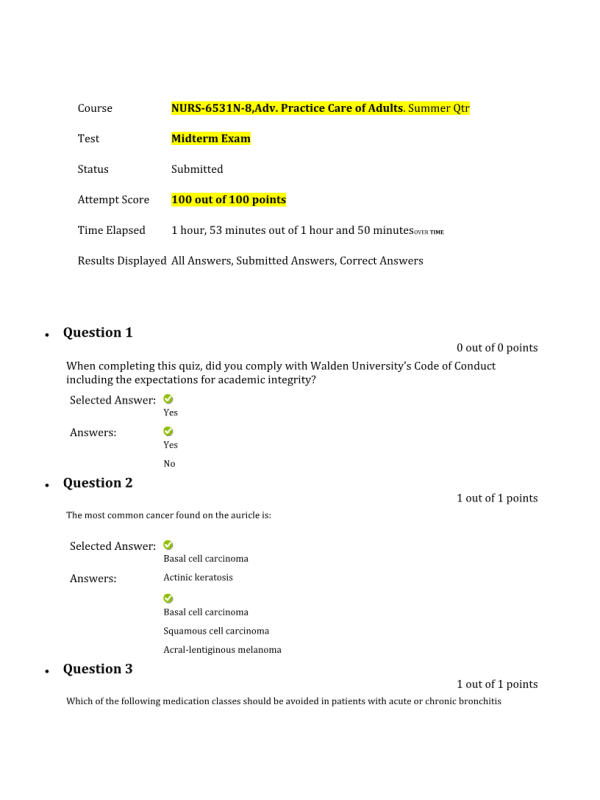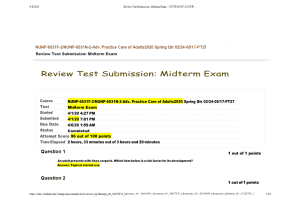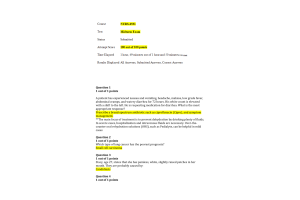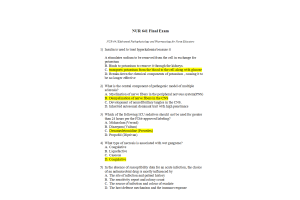NURS 6531 Week 6 Midterm Exam (100 out of 100 Points)
Course : NURS 6531 Advanced Practice Care of Adults Across the Lifespan
Contributed : Misha
- $45.00
NURS 6531 Advanced Practice Care of Adults Across the Lifespan
- Question: When completing this quiz, did you comply with Walden University’s Code of Conduct including the expectations for academic integrity?
- Question: The most common cancer found on the auricle is:
- Question: Which of the following medication classes should be avoided in patients with acute or chronic bronchitis because it will contribute to ventilation-perfusion mismatch in the patient?
- Question: A 47 year old male patient presents to the clinic with a single episode of a moderate amount of bright red rectal bleeding. On examination, external hemorrhoids are noted. How should the nurse practitioner proceed?
- Question: Which of the following patient characteristics are associated with chronic bronchitis?
- Question: A 65-year-old female with a past medical history of hypertension, hyperlipidemia, and polymyalgia rheumatica presents to urgent care with new onset left lower quadrant pain. Her current medications include omeprazole 20 milligrams po daily, lisinopril 20 milligrams po daily, simvastatin 20 milligrams po daily, and prednisone 12 milligrams po daily. The nurse practitioner suspects acute diverticulitis and possibly an abscess. The most appropriate diagnostic test for this patient at this time is:
- Question: A patient reports “something flew in my eye” about an hour ago while he was splitting logs. If there were a foreign body in his eye, the nurse practitioner would expect to find all except:
- Question: A 21 year old college student presents to the student health center with copious, markedly purulent discharge from her left eye. The nurse practitioner student should suspect:
- Question: A 35 year old man presents with radicular pain followed by the appearance of grouped vesicles consisting of about 15 lesions across 3 different thoracic dermatomes. He complains of pain, burning, and itching. The nurse practitioner should suspect:
- Question: Which type of lung cancer has the poorest prognosis?
- Question: An 83-year-old female presents to the office complaining of diarrhea for several days. She explains she has even had fecal incontinence one time. She describes loose stools 3–4 times a day for several weeks and denies fever, chills, pain, recent antibiotic use. The history suggests that the patient has:
- Question: Margaret, age 32, comes into the office with painful joints and a distinctive rash in a butterfly distribution on her face. The rash has red papules and plaques with a fine scale. What do you suspect?
- Question: Antibiotic administration has been demonstrated to be of little benefit to the treatment of which of the following disease processes?
- Question: Lisa, age 49, has daily symptoms of asthma. She uses her inhaled short-acting beta-2 agonist daily. Her exacerbations affect her activities and they occur at least twice weekly and may last for days. She is affected more than once weekly during the night with an exacerbation. Which category of asthma severity is Lisa in?
- Question: Which of the following is the most appropriate therapeutic regimen for an adult patient with no known allergies diagnosed with group A B-hemolytic strep?
- Question: A cashier complains of dull ache and pressure sensation in her lower legs. It is relieved by leg elevation. She occasionally has edema in her lower legs at the end of the day. What is the most likely cause of these problems?
- Question: Which statement below is correct about pertussis?
- Question: Which of the following is the most important diagnosis to rule out in the adult patient with acute bronchitis?
- Question: A 70 year old patient presents with left lower quadrant (LLQ) abdominal pain, a markedly tender palpable abdominal wall, fever, and leukocytosis. Of the following terms, which correctly describes the suspected condition?
- Question: Sylvia, age 83, presents with a 3 day history of pain and burning in the left forehead. This morning she noticed a rash with erythematous papules in that site. What do you suspect?
- Question: A 33-year-old female is admitted with acute pancreatitis. The nurse practitioner knows that the most common cause of pancreatitis is:
- Question: When a patient presents with symptoms of acute gallbladder disease, what is the appropriate nurse practitioner action?
- Question: A false-positive result with the fecal occult blood test can result from:
- Question: A 76-year-old male complains of weight loss, nausea, vomiting, abdominal cramping and pain. Physical findings include an abdominal mass and stool positive for occult blood. The nurse practitioner pain suspects a tumor in the small intestine. The best diagnostic test for this patient is:
- Question: A patient presents to urgent care complaining of dyspnea, fatigue, and lower extremity edema. The echocardiogram reveals and ejection fraction of 38%. The nurse practitioner knows that these findings are consistent with:
- Question: Maxine, Age 76, has just been given a diagnosis of pneumonia. Which of the following is an indication that she should be hospitalized?
- Question: A 55 year old man is diagnosed with basal cell carcinoma. The nurse practitioner correctly tells him:
- Question: Expected spirometry readings when the patient has chronic emphysema include:
- Question: An 80-year-old male admits to difficulty swallowing during the review of systems. The nurse practitioner recognizes the differential diagnosis for this patient’s dysphagia is:
- Question: A 40 year old female with history of frequent sun exposure presents with a multicolored lesion on her back. It has irregular borders and is about 11mm in diameter. What should the nurse practitioner suspect?
- Question: Which of the following is not a goal of treatment for the patient with cystic fibrosis?
- Question: The nurse practitioner is performing a physical exam on a middle-aged African-American man. Which of the following areas is a common site for melanomas in African-Americans and other dark-skinned individuals?
- Question: An adult presents with tinea corporis. Which item below is a risk factor for its development?
- Question: A patient has experienced nausea and vomiting, headache, malaise, low grade fever, abdominal cramps, and watery diarrhea for 72 hours. His white count is elevated with a shift to the left. He is requesting medication for diarrhea. What is the most appropriate response?
- Question: Janine, age 29, has numerous transient lesions that come and go, and she is diagnosed with urticaria. What do you order?
- Question: Of the following signs and symptoms of congestive heart failure (CHF), the earliest clinical manifestation is:
- Question: A 16 year old male presents with mild sore throat, fever, fatigue, posterior cervical adenopathy, and palatine petechiae. Without a definitive diagnosis for this patient, what drug would be least appropriate to prescribe?
- Question: A 70 year old man who walks 2 miles every day complains of pain in his left calf when he is walking. The problem has gotten gradually worse and now he is unable to complete his 2 mile walk. What question asked during the history, if answered affirmatively, would suggest a diagnosis of arteriosclerosis obliterans?
- Question: Which of the following statements about malignant melanomas is true?
- Question: Sheila, age 78, presents with a chief complaint of waking up during the night coughing. You examine her and find an S3 heart sound, pulmonary crackles that do not clear with coughing, and peripheral edema. What do you suspect?
- Question: Which antibiotic would be the most effective in treating community acquired pneumonia (CAP) in a young adult without any comorbid conditions?
- Question: Which of the following dermatologic vehicles are the most effective in absorbing moisture and decreasing friction?
- Question: A 70 year old patient presents with a slightly raised, scaly, erythematous patch on her forehead. She admits to having been a “sun worshiper.” The nurse practitioner suspects actinic keratosis. This lesion is a precursor to:
- Question: An elderly patient is being seen in the clinic for complaint of “weak spells” relieved by sitting or lying down. How should the nurse practitioner proceed with the physical examination?
- Question: What oral medication might be used to treat chronic cholethiasis in a patient who is a poor candidate for surgery?
- Question: A 46-year-old female with a past medical history of diabetes presents with a swollen, erythematous right auricle and is diagnosed with malignant otitis externa. The nurse practitioner knows that the most likely causative organism for this patient’s problem is:
- Question: Which of the following is not a symptom of irritable bowel syndrome?
- Question: A patient comes in complaining of 1 week of pain in the posterior neck with difficulty turning the head to the right. What additional history is needed?
- Question: Marvin, age 56, is a smoker with diabetes. He has just been diagnosed as hypertensive. Which of the following drugs has the potential to cause the development of bronchial asthma and inhibit gluconeogenesis?
- Question: The differential diagnosis for a patient complaining of a sore throat includes which of the following?
- Question: A patient presents to the primary care provider complaining of a rash on his right forehead that started yesterday and is burning and painful. The physical exam reveals an erythematous, maculopapular rash that extends over the patient’s right eye to his upper right forehead. Based on the history and examination, the most likely cause of this patient’s symptoms is:
- Question: Before initiating an HMG CoA-reductase inhibitor for hyperlipidemia, the nurse practitioner orders liver function studies. The patient’s aminotransferase (ALT) is elevated. What laboratory test(s) should be ordered?
- Question: A patient with elevated lipids has been started on lovastatin. After 3 weeks of therapy, he calls to report generalized muscle aches. The nurse practitioner should suspect:
- Question: Treatment of acute vertigo includes:
- Question: Treatment of H.pylori includes which of the following?
- Question: Carl, age 78, is brought to the office by his son, who states that his father has been unable to see clearly since last night. Carl reports that his vision is “like looking through a veil.” He also sees floaters and flashing lights but is not having any pain. What do you suspect?
- Question: In order to decrease deaths from lung cancer:
- Question: John, age 33, has a total cholesterol level of 188 mg/dL. How often should he be screened for hypercholesterolemia?
- Question: Mort is hypertensive. Which of the following factors influenced your choice of using an alpha blocker as the antihypertensive medication?
- Question: John, age 59, presents with recurrent, sharply circumscribed red papules and plaques with a powdery white scale on the extensor aspect of his elbows and knees. What do you suspect?
- Question: Harriet, a 79-year-old woman, comes to your office every 3 months for follow up on her hypertension. Her medications include one baby aspirin daily, Lisinopril 5mg daily, and Calcium 1500 mg daily. At today’s visit. Her blood pressure is 170/89. According to JNC VIII guidelines, what should you do next to control Harriet’s blood pressure?
- Question: An active 65-year-old man under your care has known acquired valvular aortic stenosis and mitral regurgitation. He also has a history of infectious endocarditis. He has recently been told he needs elective replacement of his aortic valve. When he comes into the office you discover that he has 10 remaining teeth in poor repair. Your recommendation would be to:
- Question: Appropriate therapy for peptic ulcer disease (PUD) is:
- Question: Shirley, age 58, has been a diabetic for 7 years. Her blood pressure is normal. Other than her diabetes medications, what would you prescribe today during her routine office visit?
- Question: Medicare is a federal program administered by the Centers for Medicare and Medicaid Services (CMS). The CMS has developed guidelines for Evaluation and Management coding, which all providers are expected to follow when coding patient visits for reimbursement. Which of the following is an important consideration regarding billing practices?
- Question: A 2 year old presents with a white pupillary reflex. What is the most likely cause of this finding?
- Question: Harvey has had Meniere’s disease for several years. He has some hearing loss but now has persistent vertigo. What treatment might be instituted to relieve the vertigo?
- Question: Which of the following is not a risk factor for coronary arterial insufficiency?
- Question: An 18-year-old female presents to the urgent care center complaining of severe pruritus in both eyes that started 2 days ago. Associated symptoms include a headache and fatigue. On examination, the nurse practitioner notes some clear discharge from both eyes and some erythema of the eyelids and surrounding skin. Which of the following is the most likely cause of this patient’s symptoms?
- Question: A 20 year old is diagnosed with mild persistent asthma. What drug combination would be most effective in keeping him symptom-free?
- Question: Acute rheumatic fever is an inflammatory disease which can follow infection with:
- Question: A 60 year old male diabetic patient presents with redness, tenderness, and edema of the left lateral aspect of his face. His left eyelid is grossly edematous. He reports history of a toothache in the past week which “is better.” His temperature is 100°F and pulse is 102 bpm. The most appropriate initial action is to:
- Question: If a patient presents with a deep aching, red eye and there is no discharge, you should suspect:
- Question: The National Cholesterol Education Program’s Adult Treatment Panel III recommends that the goal for low density lipoproteins in high risk patients be less than:
- Question: A patient presents with classic symptoms of gastroesophageal reflux disease (GERD). He is instructed on life style modifications and drug therapy for 8 weeks. Three months later he returns, reporting that he was “fine” as long as he took the medication. The most appropriate next step is:
- Question: Group A β-hemolytic streptococcal (GABHS) pharyngitis is most common in which age group?
- Question: The most appropriate treatment for a child with mild croup is:
- Question: A child complains that his “throat hurts” with swallowing. His voice is very “throaty” and he is hyperextending his neck to talk. Examination reveals asymmetrical swelling of his tonsils. His uvula is deviated to the left. What is the most likely diagnosis?
- Question: Salmeterol (Servent) is prescribed for a patient with asthma. What is the most important teaching point about this medication?
- Question: Which intervention listed below is safe for long term use by an adult with constipation?
- Question: A 40 year old presents with a hordeolum. The nurse practitioner teaches the patient to:
- Question: Sarah has allergic rhinitis and is currently being bothered by nasal congestion. Which of the following meds ordered for allergic rhinitis would be most appropriate?
- Question: What is the Gold standard for the diagnosis of asthma?
- Question: A patient complains of “an aggravating cough for the past 6 weeks.” There is no physiological cause for the cough. Which medication is most likely causing the cough?
- Question: Stacy, age 27, states that she has painless, white, slightly raised patches in her mouth. They are probably caused by:
- Question: Risk factors for acute otitis media (AOM) include all of the following except:
- Question: Which of the following can result from chronic inflammation of a meibomian gland?
- Question: What conditions must be met for you to bill “incident to” the physician, receiving 100% reimbursement from Medicare?
- Question: Of the following choices, the least likely cause of cough is:
- Question: The most common correlate(s) with chronic bronchitis and emphysema is(are):
- Question: Which choice below is least effective for alleviating symptoms of the common cold?
- Question: When teaching a patient with hypertension about restricting sodium, you would include which of the following instructions?
- Question: Which of the following heart murmurs warrants the greatest concern?
- Question: A patient presents with an inflamed upper eyelid margin. The conjunctiva is red and there is particulate matter along the upper eyelid. The patient complains of a sensation that “there is something in my eye.” What is the diagnosis and how should it be treated?
- Question: A 57-year-old male presents to urgent care complaining of substernal chest discomfort for the past hour. The EKG reveals ST elevations in Leads II, III, and AVF. The nurse practitioner is aware that these changes are consistent with which myocardial infarction territory?
- Question: The nurse practitioner observes a tympanic membrane that is opaque, has decreased mobility, and is without bulging or inflammation. The least likely diagnosis for this patient is:
- Question: Alan, age 54, notices a bulge in his midline every time he rises from bed in the morning. You tell him it is a ventral hernia, also known as:
- Question: A 58-year-old man is diagnosed with Barrett’s esophagus after an endoscopy. He has no known allergies. Which of the following medications is MOST appropriate to treat this patient’s disorder?
- Question: Larry, age 66, is a smoker with hyperlipidemia and hypertension. He is 6 months post-MI. To prevent reinfarction, the most important behavior change that he can make is to:
- Question: Risk factors for acute arterial insufficiency include which of the following?
- Question: Impetigo and folliculitis are usually successfully treated with:



